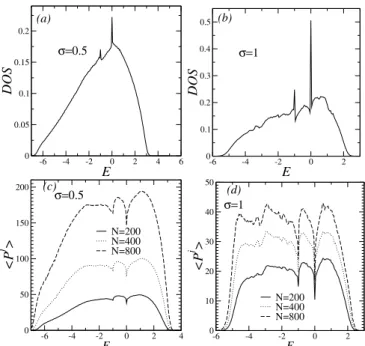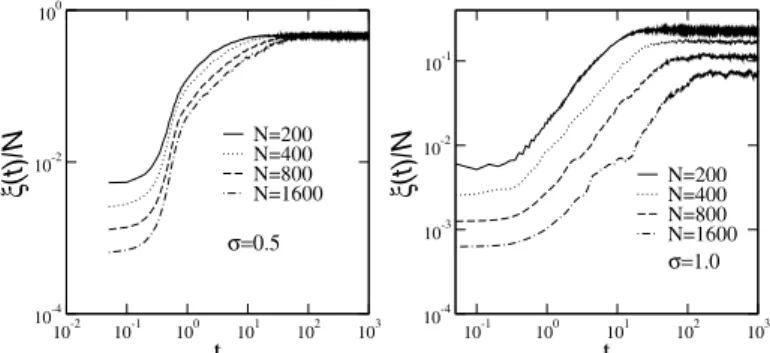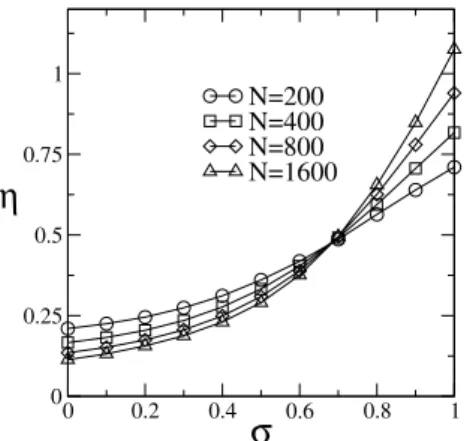Quantum Percolation of One-Electron States in Power-Law Diluted Chains
M. P. da Silva Jr., S. S. Albuquerque, F. A. B. F. de Moura, and M. L. Lyra Instituto de F´ısica, Universidade Federal de Alagoas, Macei ´o AL 57072-970, Brazil
Received 22 October, 2007
We investigate the nature of one-electron eigenstates in power-law diluted chains for which the probability of occurrence of a bond between sites separated by a distance rdecays as p(r) =1/r1+σ. Using an exact diagonalization scheme on finite chains, we compute the spreading of an initially localized wave-packet, the time dependent participation number as well as the return probability. Our results show the existence of a phase of extended states. By considering the scale invariance of the fluctuations of the participation number at the Anderson transition, we obtained that extended states emerges forσ<0.68. This limiting value is larger than the one reported in the literature for the emergence of extended states in one-dimensional Anderson models with power-law decaying couplings.
Keywords: Quantum percolation; Anderson localization; Long-range couplings
I. INTRODUCTION
The Anderson localization theory describes some relevant aspects concerning the properties of non-interacting elec-tron systems with uniformly distributed disorder. In one-dimensional (1D) and two-dimensional (2D) electronic sys-tems with short-range hopping, the scaling theory [1, 2] pre-dicts the absence of a disorder-driven metal-insulator transi-tion (MIT) for any degree of uncorrelated disorder. On the other hand, when long-range couplings are assumed, a tran-sition from localized to delocalized electronic states can be found even in 1D disordered systems[3, 4]. In this case, one has an interplay between the hopping range and the degree of disorder. The former favors propagation while the later inhibits it. It is worthwhile to mention that propagation of carriers was also obtained in low-dimensional models with short-range hopping but presenting correlated disorder, such as random dimer chains [5–8] and in chains with scale-free disorder[9–11], as well as in chains containing quasi-periodic structures, as for example Fibonacci, Thue-Morse and Harper sequences [12–14].
It was shown that an ordered 1D system with hopping terms decaying with a power-law characterized by an exponentα recovers the result for the tight-binding model forα>2 [15]. More interesting is the behavior corresponding to 0<α<1. Forα=0 an initially localized wave-packet presentsself trap-ping, i.e., the particle performs oscillations in a definite region of the lattice, visiting periodically the starting position. By in-creasingα, the localization is lost. When the power exponent equals unity, and for sufficient short times, the wave-packet diffuses with a diffusion coefficient that increases with the number of sites. This effect is absent in the model with only nearest-neighbor hoppings [15].
More recently, the dynamics of an electron in the one-dimensional Anderson model with non-random hoppings falling off as some power α of the distance between sites was investigated [16]. It was found that the larger the hop-ping range, the more extended the wave-packet becomes as time evolves. When the disorder is increased, the wave-packet tends to remain more localized. For a low degree of disorder, the exponentα=1.5 indicates the onset for fast propagation.
Moreover, the inclusion of a dc electric field introduces the effect of dynamical localization. The fast propagation found forα<1.5 is in agreement with the reported delocalization of states located close to one of the band edges [17–19].
The power-law random band matrix (PRBM) model also exhibits a delocalization transition [3, 4]. This model describes one-dimensional electronic systems with random long-range hopping amplitudes with standard deviation de-caying as 1/rα for sites at a distance r>>b, whereb is a typical bandwidth. It was shown that at α=1, this model presents an Anderson-like transition with all states being lo-calized forα>1 and extended forα<1. At the critical point α=1, the inverse participation ratio distribution, the wave-functions multifractal spectra, the level statistics and the time-evolution of the wave-packet size have been investigated both analytically and numerically [3, 4, 20–23]. Within the same spirit of the PRBM, a model for non-interacting electrons in a 2Dlattice with random on-site potentials and random power-law decaying transfer terms was numerically investigated by exploring the finite-size scaling properties of the fluctuations in the mean level spacing[24]. It was found that the one-electron eigenstates become extended for transfer terms de-caying slower than 1/r2. Finally, the Anderson transition in a 1Dchain with random power-law decaying hopping terms and non-random on-site energies was numerically characterized in ref. [25].
scheme, we will provide a detailed analysis of the nature of the one-electron eigenstates and the wave-packet dynamics. Us-ing a finite-size scalUs-ing analysis, we will also locate the criti-cal power-law exponent below which extended states emerge in this model.
II. MODEL AND FORMALISM
A. Model Hamiltonian
We consider a single electron in a 1D chain with open boundaries, described by the Anderson Hamiltonian
H= N
∑
n=1εn|nn|+ N
∑
n=mh(|n−m|)|nm| , (1)
where|nrepresents the state with the electron localized at site n. In the present random bond Anderson model, the on-site potentialsεnare site independent and in Eq. 1 were taken to beεn=0 without any loss of generality. Long-range disorder is introduced by assuming the hopping amplitudes h(n−m) to be distributed following a power-law decaying distribution. The probability of occurrence of a bond between sitesnand mdecays as
p(r=|n−m|) =1/r1+σ. (2) whereh(|n−m|) =1 with probabilityp(r)andh(|n−m|) =0 with probability 1−p(r). Forσ>1 this model is expected to have features similar to those presented by models with ran-dom short-range couplings. In this work, we will be particu-larly interested in the regime of 0<σ<1.
B. Eigenfunctions and Participation number
In the following investigation, we will analyze the quan-tum percolation transition in the above introduced model. The main quantities we used for such purpose were obtained by the direct diagonalization of the Hamiltonian on finite chains which provided all eigenstates and energy eigenvalues for each disorder realization. In studying the nature of the one-electron eigenstates, the participation moments play a central role. For a particular disorder configurationνand eigenstate, the participation number is defined as the inverse of the sec-ond moment of the probability density
Pj,ν= 1 ∑Nn=1|f
j,ν n |4
(3)
wherefnj,νis the amplitude at sitenof the j-th eigenstate from theν-th disorder realization. In our numerical computation, we performed a numerically exact diagonalization on chains with sizes ranging fromN=200 up toN=1600 sites. We averagedPj,νusing all eigestates computed from distinct dis-order realizations:
ξ= 1 MN
M
∑
ν=1N
∑
j=1Pj,ν. (4)
-6 -4 -2 0 2 4 6
E 0
0.05 0.1 0.15 0.2
DOS
σ=0.5 (a)
-6 -4 -2 0 2
E
0 0.1 0.2 0.3 0.4 0.5
DOS
σ=1 (b)
-6 -4 -2 0 2 4
E 0
50 100 150 200
<P
j >
N=200 N=400 N=800 (c)
σ=0.5
-6 -4 -2 0 2
E 0
10 20 30 40 50
<P
j >
N=200 N=400 N=800 (d)
σ=1
FIG. 1: The normalized density of states DOS versus energyE for N=200 and (a)σ=0.5, (b)σ=1. Results for DOS were aver-aged using more than 30000 disorder realizations. The participation numberPj(averaged over several realizations of disorder) versus energyE for several system sizes (N=200 up to 800), (c)σ=0.5 and (d)σ=1. Forσ=0.5 the participation number is proportional doNindicating the presence of extended states. The participation number converges to finite values forσ=1. This result suggest a localized nature of all eigentates.
We useNM=64×103states for each chain size. In addition, we computed the normalized density of states (DOS) defined byDOS(E) = (1/MN)∑j,νδ(E−Ej,ν)and the fluctuation of the participation number defined by
∆ξ=ξ2 − ξ2. (5)
The relative fluctuation of the participation number is given by
η=∆ξ/ξ. (6)
Within the framework of random and non-random long-range hopping models, it was demonstrated rigorously that the dis-tribution function of the participation function is scale invari-ant at the Anderson transition [26]. Such scale invariance has been used to monitor the critical point of long-range hopping models [27] and shall also hold for general models exhibiting a localization-delocalization transition.
C. Wave-packet Dynamics
10-2 10-1 100 101 102 103
t
10-4
10-2
100
ξ
(t)/N
N=200 N=400 N=800 N=1600
σ=0.5
10-1 100 101 102 103
t
10-4
10-3
10-2
10-1
ξ
(t)/N N=200
N=400 N=800 N=1600
σ=1.0
FIG. 2: Scaled participation numberξ/N versus timetfor several system sizes (N=200 up to 1600), (a)σ=0.5 and (b)σ=1. For
σ=0.5 the asymptotic participation number is proportional to N indicating the presence of extended states among the wave-packet components. Forσ=1, the Scaled participation numberξ/Ntends to zero as the system size is increased. This result suggests that all eigenstates are localized.
|Φ(t)=
∑
nfn(t)|n. (7) The main task is to solve the time-dependent Schr¨odinger equation for the wave-function components fn(t)(=1)
id fn(t)
dt =
N
∑
n=mh(|n−m|)fn(t). (8) Using the numerical formalism proposed in Ref. [28], the gen-eral solution of this problem can be written as:
|Φ(t)=U†exp(−iDt)U|Φ(t=0), (9) whereD is the diagonal form of the Hamiltonian and U is a unitary matrix. In what follows, we consider the electron initially localized in a single site, i.e.|Φ(t=0)=|n0.
Besides following the time evolution of the initially local-ized wave-packet, we also recorded the asymptotic scaled re-turn probability (rere-turn probability times the chain size) de-fined as:
R=N t∞
t∞
0
|fn0(t)|
2dt (10)
In general R is roughly a constant for extended states and scales proportional toN for localized states. We further cal-culated the time dependent participation number
ξ(t) =
1 ∑Nn|fn(t)|4
, (11)
averaged over distinct realizations. The participation number (ξ(t)) has been commonly used as a measurement of the typi-cal number of sites over which the wave-packet is spread.
III. RESULTS
In Fig.1, we show results for the normalized density of states DOS and the participation number. In Fig.1a, we plot
0 0.2 0.4 0.6 0.8 1
σ
05 10 15 20 25
R
N=100 N=200 N=400
FIG. 3: The asymptotic scaled return probabilityRversusσfor sev-eral system sizes (N=100 up to 400). The scaled return probability Ris roughly a constant for smallσand increase withNforσaround unit. This result reinforces the existence of an Anderson transition forσ<1.
the normalized density of states DOS versus energy E for N=200 andσ=0.5. In Fig.1b, similar data are shown for σ=1. Results for the DOS were averaged using more than 30000 disorder realizations. In both cases, two delta-like sin-gularities are observed atE=0 andE=−1. These singular-ities are associated with resonant localized modes which are located at pair of sites with the same bonds to the remain-ing chain. It is important to notice that forα=0.5 the DOS presents much smaller fluctuations than that forα=1. This feature signals that the typical localization length becomes larger as the couplings are made more long-ranged.
The average participation numberPjversus energyEfor several system sizes (N=200 up to 800) is showed in Fig.1(c) for the particular case ofσ=0.5. Fig.1(d) show our results for σ=1. To computePj, we averaged the participation number of all eigenstates jwithin a small window aroundE considering several disorder realizations. Forσ=0.5 the par-ticipation number is proportional toNindicating the presence of extended states. The average participation number does not scale proportional to the system size forσ=1. This result suggests an asymptotic localized nature of all eigentates. The dips atE=0 andE=−1 are due to the strongly localized nature of the resonant states at these energies.
In Fig.2, we show our results for the scaled participation numberξ/Nversus timet for several system sizes (N=200 up to 1600), (a)σ=0.5 and (b)σ=1. Forσ=0.5 the asymp-totic participation number is proportional toNindicating that the wave-packet has components which are extended states. Forσ=1, the scaled participation numberξ/Ntends to zero as the system size is increased. This result suggests that all eigenstates have a localized nature. It is important to stress that the asymptotic regime forσ=0.5 is reached after a very short evolution time. Due to the presence of long-range hop-pings, the initially localized wave-packet spreads exponen-tially before the saturation.
0 0.2 0.4 0.6 0.8 1
σ
0 0.25 0.5 0.75 1
η
N=200 N=400 N=800 N=1600
FIG. 4: The relative fluctuation of the participation function η=
∆ξ/ <ξ>versusσandN=200,400,800,1600 sites. The scale in-variant point signals the transition between extend and exponentially localized states.
The main parameter governing this transition is the power-law decay exponentσ. In order to locate the critical decay expo-nent, we computed some typical quantities over the full range of 0<σ<1. In Fig.3 we show the asymptotic scaled return probabilityRversusσfor distinct system sizes (N=100 up to 400). The scaled return probabilityRis roughly a constant for small σ and increase with N for largeσ. In agreement with Fig. 2, this result also indicates the existence of extended states forσ=0.5. However, due to the strong finite size ef-fects, such quantity does not allow for an accurate estimate of the critical point. To this end, the relative fluctuation of the participation number plotted as a function ofσusing data computed from distinct chain sizes represents one of the most efficient and computationally suited tools. Extended states display very weak participation number fluctuations and, as such, the relative fluctuation decreases with the system size. On the other hand, localized states have size independent fluc-tuations with the relative value saturating at a finite value as the system size is increased. At the critical point, the partici-pation number distribution is scale invariant. In Fig.4, we col-lect results of the relative fluctuation of the participation func-tion η=∆ξ/ <ξ> versusσ withN=200,400,800,1600 sites. The scale invariant point around σ=0.68(2)signals the transition between extended and exponentially localized states.
IV. SUMMARY AND CONCLUSIONS
In summary, we investigated the nature of one-electron eigenstates in power-law diluted chains for which the
prob-ability of occurrence of a bond between sites separated by a distancer decays a p(r) =1/r1+σ. This model is a pro-totype to study the quantum percolation transition in low-dimensional systems with long-range couplings. Using an ex-act diagonalization scheme on finite chains, we computed the DOS and participation number of all energy eigenstates which were used to follow the time-evolution of an initially localized wave-packet. We found that the relative fluctuation of the par-ticipation number provides a precise estimate of the critical decay exponentσc=0.68(2)separating the regimes of local-ized and extended states. For decay exponents larger than this critical value, all energy eigenstates are localized, a behavior typical of disordered systems with short-range couplings. It is important to stress that in this regime the wave-packet remains localized over a finite region of the system even though the chain is fully connected. This is a typical signature of systems presenting classical percolation but no quantum percolation. Forσ below the critical value, the long-range couplings are enough to stabilize extended states. An initially wave-packet develops a fast exponential spread over the chain. As com-pared with other classes of models with long-range couplings, such as the random band matrix model and models with long-range couplings and pure diagonal disorder, the present model is the one on which the phase of extended states is sustained for the widest range of decay exponents. Therefore, there is a range of decay exponents for which the present quantum percolation model exhibits a localization-delocalization tran-sition that is not shared by these other models. Aσ-dependent set of new critical exponents shall govern this unique transi-tion. Within this scenario, the quantum percolation transition here reported is expected to belong to a universality class dis-tinct from the two classes governing the Anderson transition in models with long-range couplings with pure diagonal as well as off-diagonal disorder. We expect the present results can stimulate further studies along this direction.
V. ACKNOWLEDGEMENTS
This work was partially supported by the Brazilian research agencies CNPq, Rede Nanobioestruturas, CAPES and FINEP and by the Alagoas State research agency FAPEAL.
[1] P.W. Anderson Phys. Rev.109, (1958) 1492.
[2] E. Abrahams, P.W. Anderson, D.C. Licciardello, and T.V. Ra-makrishnan, Phys. Rev. Lett.42, 673 (1979). For a review see, e.g., I.M. Lifshitz, S.A. Gredeskul, and L.A. Pastur,
Introduc-tion to the Theory of Disordered Systems(Wiley, New York, 1988).
[4] A.D. Mirlin and F. Evers, Phys. Rev. B62, 7920 (2000); F. Evers and A.D. Mirlin, Phys. Rev. Lett.84, 3690 (2000). [5] J.C. Flores, J. Phys.: Condens. Matter1, 8471 (1989). [6] D.H. Dunlap, H.L. Wu, and P.W. Phillips, Phys. Rev. Lett.65,
88 (1990); H.-L. Wu and P. Phillips, Phys. Rev. Lett.66, 1366 (1991); P.W. Phillips and H.-L. Wu, Science252, 1805 (1991); [7] C.A.A. da Silva, P.E. de Brito, and H. N. Nazareno, Phys. Rev.
B52, 7775 (1995).
[8] V. Bellani, E. Diez, R. Hey, L. Toni, L. Tarricone, G.B. Par-ravicini, F. Dom´ınguez-Adame, and R. G´omez-Alcal´a, Phys. Rev. Lett.82, 2159 (1999).
[9] F.A.B.F. de Moura and M.L. Lyra, Phys. Rev. Lett.81, 3735 (1998); F.A.B.F. de Moura and M.L. Lyra, Physica A266, 465 (1999).
[10] F.M. Izrailev and A.A. Krokhin, Phys. Rev. Lett. 82, 4062 (1999); F.M. Izrailev, A.A. Krokhin, and S.E. Ulloa, Phys. Rev. B63, 041102(R) (2001).
[11] F.A.B.F. de Moura, M.D. Coutinho-Filho, E.P. Raposo, and M.L. Lyra, Europhys. Lett.66, 585 (2004).
[12] P.E. de Brito, C.A.A. da Silva, and H.N. Nazareno, Phys. Rev. B51, 6096 (1995).
[13] H.N. Nazareno, P.E. de Brito, and C.A.A. da Silva, Phys. Rev. B51, 864 (1995).
[14] C.S. Ryu, G.Y. Oh, and M.H. Lee, Phys. Rev. B48, 132 (1993). [15] H.N. Nazareno and P.E. de Brito, Phys. Rev. B60, 4629 (1999). [16] P.E. de Brito, E.S. Rodrigues, and H.N. Nazareno, Phys. Rev. B
69, 214204 (2004).
[17] A. Rodr´ıguez, V.A. Malyshev, and F. Dom´ınguez-Adame, J. Phys. A: Math. Gen.33, L161 (2000).
[18] A. Rodr´ıguez, V.A. Malyshev, G. Sierra, M.A. Mart´ın-Delgado, J. Rodr´ıguez-Laguna, and F. Dom´ınguez-Adame, Phys. Rev. Lett.90, 27404 (2003).
[19] A.V. Malyshev, V.A. Malyshev, and F. Dom´ınguez-Adame, Phys. Rev. B70, 172202 (2004).
[20] R.P.A. Lima, M.L. Lyra, and J.C. Cressoni, Physica A295, 154 (2001).
[21] F.M. Izrailev, T. Kottos, A. Politi, S. Ruffo, and G.P. Tsironis, Europhys. Lett.34, 441 (1996).
[22] F.M. Izrailev, T. Kottos, A. Politi, and G.P. Tsironis, Phys. Rev. E55, 4951 (1997).
[23] A. Politi, S. Ruffo, and L. Tessieri, Eur. Phys. J. B14, 673 (2000).
[24] H. Potempa and L. Schweitzer, Phys. Rev. B 65, 201105(R) (2001).
[25] R.P.A. Lima, H.R. da Cruz, J.C. Cressoni, and M.L. Lyra, Phys. Rev. B69, 165117 (2004).
[26] F. Evers and A. D. Mirlin, Phys. Rev. Lett.84, 3690 (2000); ibidPhys. Rev. B62, 7920 (2000).
[27] A. V. Malyshev, V. A. Malyshev, and F. Dom´ınguez-Adame, Phys. Rev. B70, 172202 (2004).


